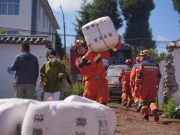(Singapore, July 8, 2020) The World Health Organization said today that it is reviewing new evidence on whether the coronavirus can spread through particles in the air.
The WHO has long said the virus is generally transmitted through large respiratory droplets, often when someone sneezes or coughs. The United Nations health agency warned in March that such droplets could be kicked up into the air where they might become airborne and linger in certain environments.
“We will be issuing our brief in the coming weeks and that will outline everything that we have in this area.”
They are contending that the WHO needs to give more weight to the role of the airborne spread of Covid-19.
“The body of evidence continues to grow and we adapt,” Dr. Soumya Swaminathan, the WHO’s chief scientist, said Tuesday. “We take this very seriously. We are of course focused on public health guidance.”
 Some scientists have criticized the WHO for being slow to issue guidance on the latest research into the coronavirus, which emerged in Wuhan, China, seven months ago. The WHO has defended its guidance, saying that it’s transparent about its review process and applies healthy skepticism to research that has not been peer-reviewed.
Some scientists have criticized the WHO for being slow to issue guidance on the latest research into the coronavirus, which emerged in Wuhan, China, seven months ago. The WHO has defended its guidance, saying that it’s transparent about its review process and applies healthy skepticism to research that has not been peer-reviewed.
The WHO’s previous warning about airborne transmission was meant specifically for health-care workers who might be exposed to the virus in “an aerosol-generating procedure” that sends the virus-carrying particles into the air. The agency in March stopped short of saying this should be a concern for the general public.
WHO officials said there is still not “definitive” evidence that indicates the virus is spreading widely by air, but it is being closely investigated.
Experts are afraid that if the airborne transmission does prove to be a major factor in the spread of the outbreak, it could have wide-ranging policy consequences.
For example, masks may prove to be even more important in reducing infections, especially in indoor environments, and even in areas where physical distancing is possible.
Since seven months ago, the pandemic has caused 115 million people from 216 countries or regions to contract the disease. More than 530,000 deaths have been confirmed worldwide.





































